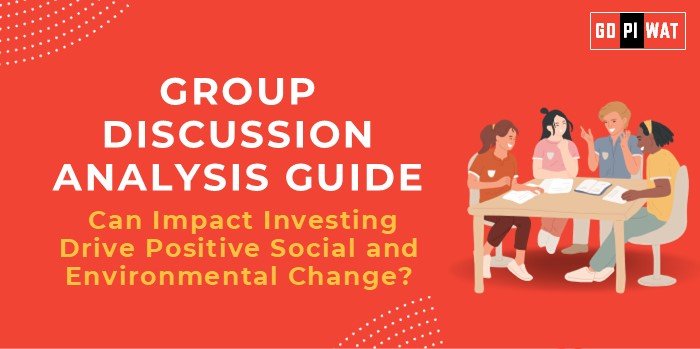📋 Group Discussion (GD) Analysis Guide
🌟 Topic: Can Impact Investing Drive Positive Social and Environmental Change?
🌐 Introduction to the Topic
- Opening Context: “Impact investing represents a confluence of profit-making and purpose-driven approaches, aimed at addressing global challenges like climate change, inequality, and access to healthcare.”
- Topic Background: Originating in the mid-2000s, impact investing emphasizes measurable environmental and social outcomes alongside financial returns. With $1.164 trillion under management globally (GIIN, 2023), it is an essential mechanism for achieving Sustainable Development Goals (SDGs).
📊 Quick Facts and Key Statistics
- Global Impact Investing Assets: $1.164 trillion (GIIN, 2023).
- Top Sectors Funded: Renewable energy (28%), healthcare (21%), education (15%).
- ESG Integration: 80% of investors include environmental, social, and governance (ESG) factors.
- India’s Market Potential: $30 billion in annual investment needs (World Bank).
👥 Stakeholders and Their Roles
- Governments: Policy formulation, offering subsidies and green bonds.
- Private Investors: Channeling funds to projects targeting SDGs.
- NGOs and Social Enterprises: Implementing impactful initiatives on the ground.
- International Organizations: Setting global standards (e.g., UNPRI, GIIN).
🏆 Achievements and Challenges
Achievements
- Renewable Energy Investments: Nearly $500 billion allocated in 2023, reducing carbon emissions by 1.5 billion tons annually (IEA).
- Social Entrepreneurship: Success stories include SELCO India providing solar power to underserved communities.
- Impact Metrics: Widespread adoption of IRIS+ and ESG frameworks for consistent evaluation.
Challenges
- Greenwashing Risks: 30% of firms exaggerate their environmental impact claims (OECD).
- Measurement Complexity: Lack of standardization in assessing social/environmental outcomes.
- Accessibility Issues: Small enterprises struggle to attract large-scale investments.
🌍 Global Comparisons and Case Studies
- United States: Leads in ESG compliance, with policies promoting impact-driven ventures.
- Scandinavia: High success in renewable energy investments, integrating social welfare models.
- Case Study: Grameen Bank (Bangladesh) – A pioneer in microfinance, directly impacting poverty alleviation and women’s empowerment.
🗣 Structured Arguments for Discussion
- Supporting Stance: “Impact investing aligns financial returns with societal goals, demonstrating its potential through renewable energy and microfinance successes.”
- Opposing Stance: “Despite its promise, impact investing often lacks accountability, risking greenwashing and under-delivery.”
- Balanced Perspective: “While the sector shows promise, regulatory oversight and improved metrics are vital for driving genuine impact.”
📝 Effective Discussion Approaches
- Opening Approaches:
- “With $1.164 trillion in assets, impact investing presents both immense promise and critical challenges.”
- “Can capital really combat climate change and inequality? Let’s explore impact investing’s true potential.”
- Counter-Argument Handling: Propose solutions such as adopting strict ESG criteria and frameworks like IRIS+ to mitigate greenwashing risks.
🔍 Strategic Analysis of Strengths and Weaknesses
- Strengths: Aligns profit with purpose; fosters innovation in social solutions.
- Weaknesses: Limited scalability in underdeveloped regions; risk of greenwashing.
- Opportunities: Growing interest in sustainable investing; potential to address global challenges like climate change.
- Threats: Regulatory gaps; skepticism about measurable outcomes.
🎓 Connecting with B-School Applications
- Real-World Applications: Leverage impact investing concepts in sustainable finance, social entrepreneurship projects, and policy analysis.
- Sample Interview Questions:
- “What are the key barriers to scaling impact investing in emerging markets?”
- “How can ESG compliance drive business value?”
- Insights for B-School Students:
- Emphasize data-driven impact assessment.
- Explore cross-functional roles blending finance, CSR, and policy-making.


